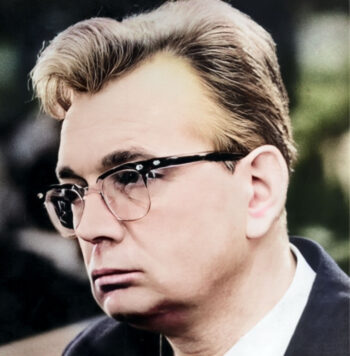Fischer, Horst
Horst Fischer (31 Dec. 1910 – 8 July 1966) was a wartime physician and SS Hauptsturmführer. From 6 November 1942 until 1944 he was deployed as camp physician at the labor camp Auschwitz-Monowitz and at the worksite of the nearby Buna branch of the German chemical giant I.G. Farbenindustrie. In September 1944, he became deputy garrison physician for the entire camp complex, subordinate to Dr. Eduard Wirths. While in Monowitz, he decided, among other things, which seriously ill or wounded inmates would be transferred to the inmate infirmary at Auschwitz-Birkenau.
In the wake of the Frankfurt Auschwitz Show Trial of 1964-65, communist East Germany staged its own Auschwitz show trial by trying Fischer for his decisions to have sick and injured inmates transferred to Birkenau, for allegedly supervising gassings, and for ordering deliveries of the insecticide Zyklon B. The trial’s focus was not so much Fischer’s personal guilt but the attempt to incriminate I.G. Farbendindustrie, the predecessor of numerous West-German chemical companies, in the claimed genocide committed at Auschwitz.
During the trial, which lasted from 10 to 25 March 1966, Fischer acted like almost all defendants during Stalinist show trials: he willingly, at times even enthusiastically, embraced and accepted all accusations unreservedly, and even added new ones. His defense lawyer was one of East Germany’s top political lawyers. (Dirks 2006, 2011; Leide 2019, pp. 167-177.)
Fischer’s description of a makeshift facility near the Birkenau Camp where he claimed to have supervised some 12 gassing actions clashes violently with the orthodox narrative. Fischer never used the by-then officially ordained term “bunker” but rather called the building a “sauna,” a term not used by any other witness, and probably inspired by the so-called Zentralsauna, Birkenau’s large hygiene building with inmate showers and hot-air disinfestation devices.
Fischer claimed that the homicidal gassing facility had only one room with two doors, and one opening to introduce Zyklon B, while the orthodoxy insists that both alleged bunkers had several rooms, each with doors and a Zyklon-B introduction hatch. After a homicidal gassing, the chamber, not equipped with any ventilation system, was presumably opened after just 15 minutes. Another quarter hour, Fischer claimed, was enough for “the poison gas to escape from the gas chamber.” After that, inmates went in and dragged out the bodies using 2-meter-long poles with hooks at one end. This absurd extraction technique is Fischer’s invention.
What completely destroys Fischer’s credibility, however, is his claim that a room packed with bodies and sprinkled with Zyklon-B pellets could be aired out successfully through just two opened doors. The pellets would have released their poison for up to two hours, and unless there was a howling wind blowing through the room, ventilating such a room would have taken many hours – up to a day or even two. (For details, see Mattogno 2016f, pp. 156-159.)
Further undermining Fischer’s credibility are his assertions about the speed at which Zyklon-B gassings allegedly worked. He seriously claimed that the gas led to unconsciousness already after a few seconds, and that breathing stopped altogether after just a few minutes. (See Rudolf 2020, p. 259.) However, Zyklon B gives off its poison only slowly, and it dissipates through a large room only gradually, so any execution in the way described would by necessity be much slower than executions in U.S. gas chambers, which took on average ten minutes (see the entry on Zyklon B and on homicidal gas chambers).
Fischer furthermore described Morgue #1 of Crematorium II, the alleged gas chamber, completely wrong. He stated that it measured 10 m × 10 m (it was 30 m × 7 m), and had a second door in the opposite wall for removing the bodies, although the room had only one door. Fischer stated that Zyklon B was dumped into the room through chimney-like objects in the roof, which runs contrary to the orthodox narrative that insists on Zyklon B not having been poured into the room itself, but into some Zyklon-B introduction devices. Furthermore, he claimed to know from hearsay that the bodies were put into a corpse elevator which deposited them directly into the furnaces, which is a unique and false claim. (See Rudolf 2020, pp. 395f.)
In reality, Fischer was one of many physicians deployed at Auschwitz desperately trying to improve health care for the inmates and the sanitary conditions. Fischer was sentenced to death and beheaded on 8 July 1966 with a guillotine. (See Mattogno 2016a, and the many health-related entries in Mattogno 2023, Part 1, for details).


You need to be a registered user, logged into your account, and your comment must comply with our Acceptable Use Policy, for your comment to get published. (Click here to log in or register.)